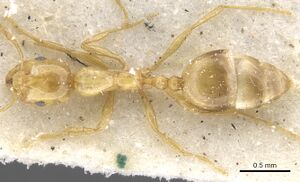Monomorium firmum
| Monomorium firmum | |
|---|---|

| |
| Scientific classification | |
| Kingdom: | Animalia |
| Phylum: | Arthropoda |
| Class: | Insecta |
| Order: | Hymenoptera |
| Family: | Formicidae |
| Subfamily: | Myrmicinae |
| Tribe: | Solenopsidini |
| Genus: | Monomorium |
| Species: | M. firmum |
| Binomial name | |
| Monomorium firmum Santschi, 1926 | |
A collection of this ant was made in miombo woodland. Monomorium firmum has only been collected a few times.
Identification
Bolton (1987) - A member of the M. schultzei complex in the M. monomorium species group. This relatively large yellow species is a conspicuous member of the complex. It is closest related to Monomorium vecte, also known from Zimbabwe, the two together being distinguished from the remaining schultzei-complex members which have relatively large propodeal spiracles by their dense pilosity. Of all schultzei-complex members in which the metanotal groove is broad and traversed by long conspicuous cross-ribs, and the propodeal spiracle is large, only firmum and vecte have 8 or more pairs of hairs on the promesonotal dorsum. Differences separating the two are noted under vecte.
Keys including this Species
Distribution
Latitudinal Distribution Pattern
Latitudinal Range: -19.08333° to -19.08333°.
| North Temperate |
North Subtropical |
Tropical | South Subtropical |
South Temperate |
- Source: AntMaps
Distribution based on Regional Taxon Lists
Afrotropical Region: Zimbabwe (type locality).
Distribution based on AntMaps
Distribution based on AntWeb specimens
Check data from AntWeb
Countries Occupied
| Number of countries occupied by this species based on AntWiki Regional Taxon Lists. In general, fewer countries occupied indicates a narrower range, while more countries indicates a more widespread species. |

|
Estimated Abundance
| Relative abundance based on number of AntMaps records per species (this species within the purple bar). Fewer records (to the left) indicates a less abundant/encountered species while more records (to the right) indicates more abundant/encountered species. |

|
Biology
Castes
Images from AntWeb

| |
| Syntype of Monomorium firmum. Worker. Specimen code casent0902234. Photographer Will Ericson, uploaded by California Academy of Sciences. | Owned by NHMUK, London, UK. |
Nomenclature
The following information is derived from Barry Bolton's Online Catalogue of the Ants of the World.
- firmum. Monomorium firmum Santschi, 1926b: 231 (w.) ZIMBABWE.
- Type-material: syntype workers (number not stated).
- Type-locality: Zimbabwe (“S Rhodesia”): Vumba Mts, Cloudlands, 6000 ft, 6-17.iv.1923 (G. Arnold).
- Type-depositories: BMNH, NHMB.
- Status as species: Ettershank, 1966: 89; Bolton, 1987: 389 (redescription); Bolton, 1995b: 262.
- Distribution: Zimbabwe.
Unless otherwise noted the text for the remainder of this section is reported from the publication that includes the original description.
Description
Worker
Bolton (1987) - TL 2.6-2.8, HL 0.58-0.66, HW 0.46-0.54, CI 79-83, SL 0.50-0.56, SI 100-109, PW 0.30-0.33, AL 0.70-0.76 (10 measured).
Clypeal carinae conspicuous, relatively close together, feebly divergent anteriorly and sometimes the carinae broken or interrupted at about their midlength. Space between the clypeal carinae shallowly transversely concave. Anterior margin of narrow prominent median section of clypeus weakly concave, the anterior and lateral margins of this section separated by blunt angles, without projecting denticles. Maximum diameter of eye 0.20-0.22 x HW and with 6-7 ommatidia in the longest row. With the head in full-face view the eyes close to the midlength of the sides, usually the posterior margins of the eyes at or even slightly behind the midlength of the sides. Antennal scapes, when laid straight back from their insertions, reaching or slightly surpassing the occipital margin. Sides of head evenly shallowly convex in full-face view and the occipital margin shallowly convex or the median area more or less flat. Promesonotum in profile a low convexity, descending behind to the broad impressed metanotal groove which is traversed by long strong cross-ribs. Propodeal spiracle large and conspicuous. Petiole node in profile relatively low, broadly subconical and with both anterior and posterior faces weakly convex. Subpetiolar process a conspicuous lobe. Postpetiole lower than petiole, smaller and more broadly rounded in profile. All dorsal surfaces of head and body with numerous standing hairs, the promesonotum with more than 8 pairs. Mostly unsculptured and shining except for scattered hair-pits, but the metanotal groove crossribbed and the mesopleuron in some with traces of weak reticulate sculpture. Colour yellow.
Type Material
Bolton (1987) - Syntype workers, Zimbabwe: Vumba Mts, 6000 ft (1830 m), Cloudlands 6-17.iv.1923 (G. Arnold) (The Natural History Museum; Naturhistorisches Museum, Basel) [examined].
References
- Bolton, B. 1987. A review of the Solenopsis genus-group and revision of Afrotropical Monomorium Mayr (Hymenoptera: Formicidae). Bulletin of the British Museum (Natural History). Entomology. 54: 263-452..
- Santschi, F. 1926b. Description de nouveaux Formicides éthiopiens (IIIme partie). Rev. Zool. Afr. (Bruss.) 13: 207-267 (page 231, worker described)
References based on Global Ant Biodiversity Informatics
- IZIKO South Africa Museum Collection

